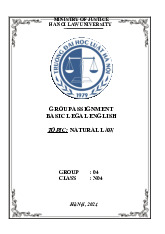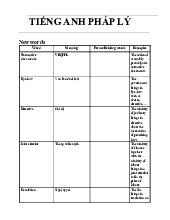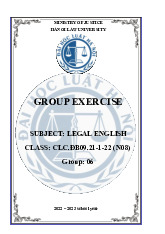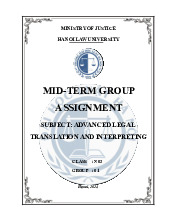














Preview text:
lOMoAR cPSD| 58412604 BỘ TƯ PHÁP
TRƯỜNG ĐẠI HỌC LUẬT HÀ NỘI BÀI TẬP NHÓM
SUBJECT: BASIC LEGAL ENGLISH 03 TOPIC 03
TASK 03: CRIMINAL LAW IN VIET NAM. LỚP: 4728 lOMoAR cPSD| 58412604 NHÓM: TL 03
Hà Nội, tháng 1 năm 2024
BIÊN BẢN XÁC ĐỊNH MỨC ĐỘ THAM GIA VÀ
KẾT QUẢ THAM GIA LÀM BÀI TẬP NHÓM
Ngày:……./……../ 2024 Địa điểm: Trường Đại học Luật Hà Nội
Nhóm số:……… Lớp……… Khoa:…………………………………
Tổng số sinh viên của nhóm: + Có mặt:…………
+ Vắng mặt:…………. Có lý do:………….……Không có lý do:………………….
Môn học:…………………………………..
Xác định mức độ tham gia và kết quả tham gia của từng sinh viên trong việc thực hiện bài tập nhóm số:……….. Kết quả như sau: STT Họ và tên Đánh giá của sinh Đánh giá của giáo viên Mã sinh viên Sinh viên viên A B C ký tên Điểm Điểm Giáo viên ký tên (số) (chữ) 1 X 2 X 3 X 4 X 5 X
Hà Nội, ngày……….tháng………năm 2024 TRƯỞNG NHÓM
Kết quả điểm bài viết:
+ Giáo viên chấm thứ nhất:………………………………
+ Giáo viên chấm thứ hai:……………………………….. lOMoAR cPSD| 58412604
Kết quả điểm thuyết trình:
Giáo viên cho thuyết trình:……………………………….
Điểm kết luận cuối cùng: ………………………………...
Giáo viên đánh giá cuối cùng:……………………………………… lOMoAR cPSD| 58412604 Table of Contents
I) INTRODUCTION................................................................................................................................ ..4
II) THE DEFINITION OF CRIMINAL LAW IN VIET
NAM................................................................5
1) What is Criminal law ?......................................................................................................................5
2) The principle of Criminal law in Viet Nam.......................................................................................5 III) ELEMENT
CONSTITUTING............................................................................................................6
1) Objective Aspect of the Crime:..........................................................................................................6
2) Subjective Aspect of the Crime:........................................................................................................6
3) Object of the Crime:...........................................................................................................................6
4) Subject of the Crime:.........................................................................................................................6 IV) TYPES OF
CRIMES...........................................................................................................................7
1) Crimes Against Persons.....................................................................................................................7
2) Crimes Against Property....................................................................................................................7
3) Inchoate Crimes.................................................................................................................................8
4) Statutory Crimes................................................................................................................................8
5) White-Collar Crimes..........................................................................................................................8
6) Other Categories of Crimes...............................................................................................................9 V) PUNISHMENT FOR
CRIME............................................................................................................10
1) When an offender recceỉve their punishment..................................................................................10
2) Some main types of criminal penalties............................................................................................10
3) The meaning of these punishments..................................................................................................10
VI) The process of trying a criminal case in Viet Nam...........................................................................11
1) Investigation Stage...........................................................................................................................11 lOMoAR cPSD| 58412604
2) Prosecution and Trial Stage.............................................................................................................11
3) Verdict and Sentencing Stage..........................................................................................................11
VII) Conclusion.......................................................................................................................................12
IIX) Reference.........................................................................................................................................13 lOMoAR cPSD| 58412604 I) INTRODUCTION
Criminal law is a vital component of the legal system that defines actions considered
harmful to society and prescribes penalties for those who commit them. Its primary
purpose is to protect the public, maintain social order, punish offenders, and deter future
crimes. In Vietnam, criminal law plays a crucial role in safeguarding national security,
protecting human rights, and ensuring justice. For an act to be classified as a crime, it
must meet certain criteria, including wrongful conduct, harmful consequences, and fault
on the part of the perpetrator. These elements ensure that only acts posing a significant
threat to society are prosecuted.Crimes in Vietnam are categorized into various types,
such as murder, robbery, theft, and fraud. Each type varies in severity, with penalties
proportionate to the gravity of the offense. Punishments may include imprisonment,
fines, non-custodial reform, or bans from holding specific positions. These penalties aim
not only to punish offenders but also to rehabilitate them and discourage others from
engaging in similar conduct.The criminal justice process in Vietnam follows a
systematic approach. Law enforcement agencies investigate crimes and collect evidence,
after which cases are brought to court for trial. The court examines the evidence,
determines guilt or innocence, and imposes appropriate penalties if necessary. This
structured system reflects Vietnam's commitment to justice and the rule of law, ensuring
that criminal acts are addressed fairly and effectively while safeguarding the rights of all involved.
II) THE DEFINITION OF CRIMINAL LAW IN VIET NAM
1) What is Criminal law ?
1.1 According to The Institute for International Criminal Investigations (IICI) : Public
international law governs the actions of states and how states interact with each other
and individual citizens. Public international law involves rules and principles that deal
with the conduct, rights and obligations of states and international organisations, as well
as dealing with relations among states.
1.2 International criminal law is a subset of public international law, and is the main
subject of these materials. While international law typically concerns inter-state
relations, international criminal law concerns individuals. In particular, international lOMoAR cPSD| 58412604
criminal law places responsibility on individual persons—not states or organisations—
and proscribes and punishes acts that are defined as crimes by international law.- followed by IICI.
1.3. Vietnam's Criminal Law is a branch of VietNam legal systems. In Article 1 of
Vietnam’s Criminal Code 2015 (Law No. 100/2015/QH13 of November 27, 2015)
defines that “The Criminal Code is meant to protect Vietnam’s sovereignty and security;
protect the socialism regime, human rights, citizenship rights; protect the equality
among ethnic groups; protect interests of the State; organize and protect the law; punish
crimes; raise people’s awareness of compliance with the law; prevent and fight crimes.
This Code provides for crimes and punishments.”
2) The principle of Criminal law in Viet Nam
2.1 An act is considered a crime, penalized by penal measures and bearing other penal
consequences if these are provided for in the criminal law. Vietnam’s Penal Code
provides: “A crime is an act dangerous to society and prescribed in the Penal Code”
(Article 8), and “Only those persons who have committed crimes defined by the Penal
Code shall bear penal liability therefore” (Article 2).
2.2 Application of the criminal law must be based on strict and consistent observance,
execution and application of its provisions, as clearly stated in Article 45 of the Penal
Code: “When deciding penalties, the courts shall base themselves on the provisions of
the Penal Code, taking into consideration the nature and extent of danger posed to
society by the acts of offense, the personal records of the offenders and any
circumstances that attenuate or aggravate penal liability.”
2.3 The criminal law must not be applied on the principle of similarity. Under Articles 2
and 8 of the Penal Code, only the criminal law can prescribe crimes and penalties such
that the similarity in crimes and similarity in penalties shall not apply.
III) ELEMENT CONSTITUTING
In the criminal law system of Vietnam, a crime is determined through the following four constitutive elements: lOMoAR cPSD| 58412604
1) Objective Aspect of the Crime:
○ Dangerous act to society: This refers to an action or omission that violates
the law and causes harm to social order, as well as the legitimate rights and
interests of individuals or organizations.
○ Dangerous consequences to society: These are the damages caused by the
criminal act, which may include material harm (such as property, life,
health) or non-material harm (such as reputation, honor). This consequence
is an important factor in determining the severity of the act.
2) Subjective Aspect of the Crime:
○ Fault: This reflects the intent of the offender. Fault can be either intentional
(the offender consciously desires the result) or negligent (the offender does
not desire the result but still causes harm).
○ Motive for committing the crime: This is the reason that drives the offender
to commit the illegal act, such as greed, hatred, or personal gain.
○ Purpose of committing the crime: This refers to the intended outcome the
offender seeks to achieve, such as killing someone to steal their property.
3) Object of the Crime:
○ Direct object: This is the specific entity directly harmed by the crime, such
as the life, health, or property of the victim.
○ Indirect object: This refers to the rights or social order that the crime
indirectly affects, such as national security, personal freedom, or social order.
4) Subject of the Crime:
○ The subject is an individual or legal entity: To be the subject of a crime, an
individual must have criminal responsibility capacity, meaning they must be
able to understand and control their actions.
○ Age of criminal liability: The individual committing the crime must meet
the legal age requirement for criminal responsibility.
All of these elements work together to determine whether an act is considered a crime. lOMoAR cPSD| 58412604
In order for an act to be deemed a crime, it must fully satisfy these constitutive elements. IV) TYPES OF CRIMES
1) Crimes Against Persons
These crimes involve direct harm or threats to individuals and are considered the most
severe due to their impact on victims' lives and well-being. ● Examples:
○ Murder: Intentional killing of another person.
■ Example: Planning and executing a homicide for personal gain or revenge.
■ Penalties: Life imprisonment or the death penalty, depending on jurisdiction.
○ Assault: Threatening or attempting to inflict physical harm on someone.
■ Example: Waving a weapon at someone in a threatening manner.
○ Kidnapping: Forcibly detaining or transporting someone without their consent.
■ Example: Taking a child for ransom or to exert control over a victim.
○ Sexual Offenses: Includes rape, sexual harassment, and sexual abuse.
■ Example: Forcing someone into non-consensual sexual activities.
2) Crimes Against Property
These offenses involve the unauthorized taking, destruction, or damage of property belonging to others. ● Examples:
○ Theft: Unlawfully taking someone else’s property with the intent to
permanently deprive them of it.
■ Example: Shoplifting, stealing a wallet, or car theft. lOMoAR cPSD| 58412604
○ Robbery: Taking property from a person using force, intimidation, or violence.
■ Example: Holding someone at gunpoint to steal their belongings.
○ Burglary: Entering a building or property unlawfully with the intent to
commit a crime, typically theft.
■ Example: Breaking into a home to steal valuables.
○ Arson: Deliberately setting fire to property.
■ Example: Burning down a building to collect insurance money. ○
Vandalism: The intentional destruction or defacement of property.
■ Example: Spray-painting graffiti on public walls or breaking windows.
3) Inchoate Crimes
These crimes involve acts that are steps toward committing another crime, even if the
ultimate crime is not completed. ● Examples:
○ Attempt: Trying but failing to commit a crime.
■ Example: Attempting to break into a safe but being interrupted by law enforcement.
○ Conspiracy: An agreement between two or more people to commit a crime,
even if the crime is not carried out.
■ Example: Planning a bank robbery with a group but failing to execute it.
○ Solicitation: Persuading or encouraging someone to commit a crime.
■ Example: Hiring a hitman to harm someone.
4) Statutory Crimes
These offenses involve actions prohibited by statutes enacted for public welfare and safety. lOMoAR cPSD| 58412604 ● Examples:
○ Driving Under the Influence (DUI): Operating a vehicle while impaired by alcohol or drugs.
■ Example: Drunk driving that results in an accident.
○ Drug Offenses: Possession, distribution, or manufacturing of illegal substances.
■ Example: Smuggling heroin or running a meth lab.
○ Underage Drinking: Consuming alcohol below the legal drinking age.
■ Example: A teenager drinking at a party in a jurisdiction where the legal age is 21.
5) White-Collar Crimes
Non-violent offenses committed in professional or business settings, often for financial gain. ● Examples:
○ Fraud: Deception for financial or personal gain.
■ Example: Committing tax fraud by falsifying income records.
○ Embezzlement: Misappropriating funds entrusted to one’s care.
■ Example: An employee transferring company money to their personal account.
○ Money Laundering: Concealing the origins of money obtained through
illegal activities by funneling it through legitimate businesses.
■ Example: Using a restaurant to process money earned from drug trafficking.
○ Insider Trading: Using confidential information for financial gain in the stock market.
■ Example: Selling company shares before a public announcement of financial trouble. lOMoAR cPSD| 58412604
6) Other Categories of Crimes
● Cybercrimes: Offenses using technology or the internet.
○ Hacking: Gaining unauthorized access to computer systems.
■ Example: Breaching a bank’s security system to steal funds.
○ Identity Theft: Stealing someone’s personal information for fraudulent purposes.
■ Example: Using another person’s credit card details to make purchases.
● Hate Crimes: Crimes motivated by bias against race, religion, gender, or sexual orientation.
○ Example: Vandalizing places of worship or assaulting someone due to their ethnicity.
● Organized Crimes: Illegal activities carried out by structured groups or syndicates.
○ Drug Trafficking: Manufacturing and distributing illegal drugs.
○ Human Trafficking: Forcing individuals into labor or sexual exploitation.
○ Smuggling: Illegally transporting goods, such as weapons or contraband.
V) PUNISHMENT FOR CRIME
1) When an offender recceỉve their punishment
When a person / people are convicted, they will be punished by the decisions that were
issued by the Court. These decisions are in consideration of the nature and danger of the
crime to society, record of the offender, mitigating factors, and aggravating factors.
2) Some main types of criminal penalties
1. Imprisonment is a common form of punishment, with varying durations ranging
from several months for minor offenses to life imprisonment or even the death
penalty for the most serious crimes, such as murder, drug trafficking, and treason.
2. Fines are also frequently utilized, particularly for economic crimes, corruption,
and offenses against property. The amount of the fine is determined based on the
severity of the offense and the offender's financial capacity. lOMoAR cPSD| 58412604
3. Bans from holding certain positions or performing certain jobs: Courts may
also impose restrictions on certain professions or positions, preventing convicted
individuals from holding specific jobs or engaging in certain activities. These
restrictions are often applied in cases involving professional misconduct or abuse of trust
4. Other penalties: Including warnings, probation, and community service. 1)
Warnings are typically issued for minor first-time offenses.
2) Probation is allowing offenders to remain in the community under
supervision, subject to certain conditions.
3) Community service is also employed, requiring offenders to perform unpaid
work for the benefit of the community.
The determination of the appropriate punishment is a complex process that takes into
account various factors, including the circumstances of the offense, the offender's
criminal history, and any mitigating or aggravating factors
3) The meaning of these punishments
The Vietnamese legal system also recognizes the importance of rehabilitation and
reintegration, with efforts made to provide offenders with opportunities for education,
vocational training, and psychological support during their time in prison. The goal is to
reduce recidivism and facilitate the offender's successful return to society upon release.
The application of criminal punishment in Vietnam is subject to due process safeguards,
ensuring that individuals are treated fairly and their rights are protected. These
safeguards include the right to a fair trial, the presumption of innocence, and the right to
legal representation. The system strives to balance the need for punishment with the
principles of justice, fairness, and human dignity.
VI) The process of trying a criminal case in Viet Nam
1) Investigation Stage
• When a crime occurs, the police are responsible for starting the investigation. • Main Tasks: lOMoAR cPSD| 58412604
○ Collect evidence from the crime scene, such as fingerprints, photos, or objects related to the crime.
○ Interview witnesses and victims to gather information.
○ Question suspects to determine their involvement in the crime.
• If there is sufficient evidence, the police may detain or arrest the suspect.
• At the end of this stage, the investigation file is sent to the Procuracy for review.
2) Prosecution and Trial Stage
• After receiving the case file, the Procuracy examines the evidence to decide
whether to bring the case to court.
• If there is enough evidence, an indictment is prepared, detailing the charges against the accused.
• The case is then brought to trial in the People’s Court. • At the Trial:
○ The judges read the charges and listen to the evidence presented by the prosecutor and the defense.
○ Witnesses and experts may testify to support their arguments.
○ Both the prosecutor and the defence lawyer argue their sides.
3) Verdict and Sentencing Stage
• The court carefully reviews the evidence, witness statements, and arguments from both sides. • The judges then decide:
a) If the accused is not guilty, they are released.
b) If the accused is guilty, the court announces the punishment, which could
be: A fine, probation, imprisonment, or other penalties.
• In cases of dissatisfaction with the decision, the accused, the victim, or the Procuracy can file an appeal. lOMoAR cPSD| 58412604 VII) Conclusion
Criminal law in Vietnam serves as a cornerstone of the nation’s legal system, providing a
framework for maintaining social order, protecting public safety, and upholding justice.
Rooted in both traditional values and modern legal principles, it has evolved to address
contemporary challenges such as organized crime, corruption, and cybercrime. The
Vietnamese Penal Code reflects the country’s commitment to a balance between punitive
measures and rehabilitation, ensuring that criminal justice promotes fairness and the
reintegration of offenders into society.
With ongoing legal reforms, Vietnam aims to align its criminal law with international
standards while preserving its unique cultural and legal traditions. These efforts are
crucial in fostering a legal system that is not only effective in combating crime but also
respects human rights and enhances public trust. Ultimately, Vietnam’s criminal law
plays a vital role in building a just and secure society, paving the way for sustainable
social and economic development. IIX) Reference
1. Vietnam Law and Legal Forum & PHAM, D. (2008, 02 25). Basic
principles of the criminal law. History & Law.
https://vietnamlawmagazine.vn/basic-principles-of-the-criminal- law4397.html
2. Krajišnik, M. (n.d.). What is International Criminal Law? IICI. Retrieved January 4, 2025, from
https://iici.global/wpd/wp-content/uploads/2024/05/icls-training-
materialssec-2-what-is-intl-law2.pdf
3. Law No. 100/2015/QH13 of November 27, 2015 of VietNam’s Criminal Code.



